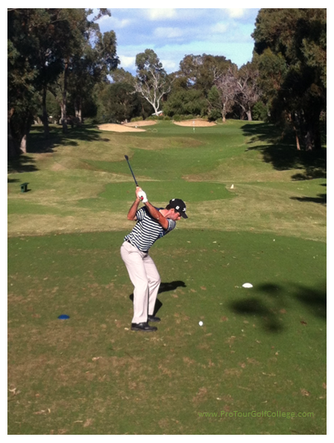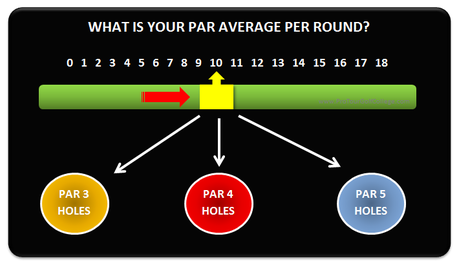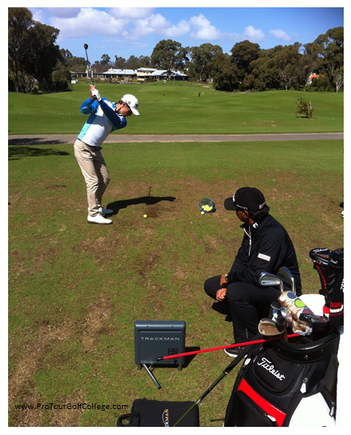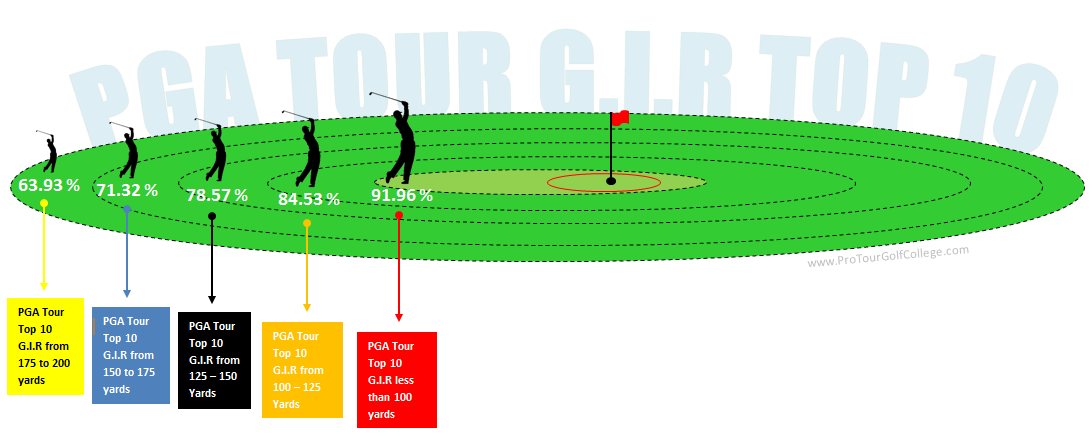The Simple and Overlooked Factor That Every PGA Tour Golfer Knows and You Need to Learn Today6/9/2013
 At 150 - 175 yards what is your G.I.R percentage? At 150 - 175 yards what is your G.I.R percentage? I personally don’t think it’s always helpful to think that the golf improvement process can be fast-tracked to produce lower golf scores, because it is unrealistic as every golfer learns in his or her own best way. Some learn some golf skills faster than others, not always because of the quality of the instruction, (although this certainly helps) but mostly because of the way each golfer processes information and translates it into performance. The time it takes to improve your golf score is relative to the relevance of what you work on, and how much of it you do. There are two things you have to be able to integrate successfully into your golf practice sessions as an elite golfer to generate improvement;
How much practice you do is based on your available time and also what your goals are as they relate to performance improvement. If you want to improve your performance there's one thing that you can do that will help you to reach your performance goals sooner. Increase the amount of pars you make in every round and your golf score average will improve. Now I know that this is simple and obvious, but you would be surprised at how many advanced and elite golfers focus on anything but making more pars per round.  The standard of a golf hole is its par, and your responsibility is to make as many as you can in 18 holes. So practicing efficiently really gets down to practicing the golf skills that have the most effect of making more pars in a round of golf. So let’s say that you average 10 pars per round, what could you practice more of, and also better to increase your par average to 12 pars per round? Well, of all the areas that you could evaluate, a good place to start is to evaluate your par 3, par 4 and par 5 performances. What is you par average for the par 3, par 4 and par 5 holes for your last 15 competitive rounds? Do you know? What we are talking about is your total strokes under or over par on these holes. The way you work it out is to divide the total amount of strokes your played on par 3, 4 and 5 holes and divide this total into the total holes you played. Let me explain what I mean. Rory McIlroy ranked 2nd on the PGA Tour in 2012 for his par 3 Scoring Average. He had a total of 648 strokes on the 216 par 3 holes he played on the PGA Tour. So if you divide his total strokes of 648 into the total holes he played 216 you get a par 3 Scoring Average of 2.99 (648 ÷ 216 = 2.99). So for the 60 rounds that Rory played he played the 216 par 3 holes in minus 2 under par for the season. Jason Dufner ranked 4th in his par 4 Scoring Average in 2012 on the PGA Tour. He had a total of 3,552 strokes on 888 par 4 holes he played. So if you divide his total strokes of 3552 into the total holes he played 888 you get a par 4 Scoring Average of 4.00 (3552 ÷ 888 = 4.00). For Jason Dufner’s 70 rounds played, he played the 888 par 4 holes in 10 under par for the season. Phil Mickelson ranked 15th in 2012 for his par 5 Scoring Average on the PGA Tour. He had a total of 1197 strokes on the 261 par 5 holes he played. When you divide his strokes played against the holes he completed he had a par 5 Scoring Average of 4.59 (1197 ÷ 261 = 4.59). 4.59 equates to 109 under par on par 5 holes for the 79 rounds he played in 2012. On a par 72 layout you will probably have four par 3 holes, ten par 4 holes and four par 5 holes.
 David working with a student on distance control with Trackman David working with a student on distance control with Trackman Would you make more pars if you hit more greens in regulation on par 3, 4 and 5 holes? I know your answer would be yes, but it’s a pretty vague question, so let’s me be more specific. What is your percentage of greens hit in regulation for the following distance ranges over your last 15 competitive rounds? 1) What is your greens hit in regulation average from less than 100 yards (90 metres)? ........... ______________ 2) What is your greens hit in regulation average from 100 to 125 yards (90 to 114 metres)? ..... ______________ 3) What is your greens hit in regulation average from 125 to 150 yards (114 to 136 metres)? ... ______________ 4) What is your greens hit in regulation average from 150 to 175 yards (136 to 159 metres)? ... ______________ 5) What is your greens hit in regulation average from 175 to 200 yards (159 to 182 metres)? ... ______________ Here’s a summary of the three great golfers I mentioned earlier who are also recent major winners. Have a close look at their statistics for their score average against par, and their greens hit in regulation for the 5 distance ranges I've chosen. Yes I could have gone out further from the hole but I really wanted to focus on shot-making skills where the longest golf club used was a long iron or possibly a hybrid into the green right down to a wedge. Notice how they all play par 3 and 4 holes around par and annihilate the par 5 holes? This is very common with PGA Tour golfers. Notice also their greens hit in regulation percentage is around 60 to 90 percent for the five distance ranges. Their competitive score average is a reflection of how effectively they play their par 3, 4 and 5 holes and your responsibility (with the help of your golf instructor) is to design your golf practice routines to help you to produce better performances against par. Now if you’re like many advanced and elite golfers you probably have a fair idea already what your greens hit in regulation percentage is per round, but more than likely you've never broken it down into the five distance ranges described above to identify your weakest approach shot distance range? The top golfers on the PGA Tour know what their weakest distance ranges are when hitting approach shots into the green because they can look them up on the PGA Tour website. And because they do know, they can work closely and more effectively with their golf swing coaches on specific strategies to improve their weak approach shot distances thereby increasing their chances of lowering their competitive score average, and in-turn increasing the potential to earn more income. Now you might not be able to have access to as many statistics as PGA Tour players can but you can certainly start tracking your approach shots into greens on every hole over the next 4 to 6 weeks so you can identify which distance range/s are your weakest.
Look for patterns in your score against par average by identifying your par 3, par 4 and par 5 performances, then work out which distance range/s are keeping your score average higher. Are you more likely to make bogey or worse when you hit your tee shots or approach shots from 175 to 200 yards? Or are you weaker from 125 to 150 yard range? This is a useful way to diagnose problems in your long game that keep your par average higher than you want it. Improve your par average and you will lower your score average. Keep it simple, and focus on improving your greens hit in regulation on your weakest approach shot range and you will discover that when you will increase your par average you will decrease your score average. It doesn't get much simpler than that. Lawrie Montague and David Milne - Pro Tour Golf College Your Success On Tour is Our Business
Andrew
11/9/2013 04:10:02 am
Great article I find this information very useful for managing expectations, course management, and goal setting. 11/9/2013 06:25:52 am
Thank you Andrew,
Lisa
11/9/2013 07:36:57 am
.
Lisa
12/9/2013 09:09:51 am
Please read: I have a mental problem .... instead of "I have a ental problem ..." 13/9/2013 05:22:42 am
Hi Lisa thanks for your question. Comments are closed.
|
Archives
June 2019
|
Proudly Supported By
Copyright © 2011 - 2018 Pro Tour Golf College
Website Managed By Golf Performance Media
All Rights Reserved
Website Managed By Golf Performance Media
All Rights Reserved





 RSS Feed
RSS Feed



